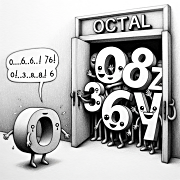Decimal to Octal

Welcome to our Decimal to Octal Converter! This online tool lets you easily convert decimal numbers to octal equivalents. Whether you're a student, programmer, or math enthusiast, our converter provides accurate results quickly.
Decimal to octal conversion involves transforming a decimal (base-10) number into its octal (base-8) representation. In the octal system, digits can range from 0 to 7. Each octal digit corresponds to three binary digits (bits).
Decimal to Octal Converter
| Decimal: base10 | |
| Decimal Places # | |
Result: | |
|
Calculator
- enter the decimal number you want to convert. The number can be positive or negative and can include fractional parts.
- the number of decimal places you require for the octal result
Result
- the octal equivalent of your decimal number
Here's how the conversion works:
Integer Part Conversion:
- Divide the decimal number by 8.
- Record the remainder, which represents the least significant octal digit (LSO).
- Repeat the division process with the quotient until it becomes zero.
- The octal equivalent is obtained by reading the remainders in reverse order..
Fractional Part Conversion (if applicable):
- Multiply the fractional part by 8
- Record the integer part of the result, which represents the next digit after the decimal point.
- Repeat the multiplication process with the fractional part until it becomes zero or until the desired precision is reached.
Example Conversion:
Convert the decimal number 1234.567 to octal
Integer Part Conversion:
- Dividing 1234 by 8, we get quotient 154 and remainder 2.
- Dividing 154 by 8, we get quotient 19 and the remainder 2.
- Dividing 19 by 8, we get quotient 2 and remainder 3.
- Dividing 2 by 8, we get quotient 0 and remainder 2.
Fractional Part Conversion:
- Multiplying 0.567 by 8, we get 4.536. The integer part is 4.
- Multiplying 0.536 by 8, we get 4.288. The integer part is 4.
- Multiplying 0.288 by 8, we get 2.304. The integer part is 2.
- Multiplying 0.304 by 8, we get 2.432. The integer part is 2.
- Multiplying 0.432 by 8, we get 3.456. The integer part is 3.
- Multiplying 0.456 by 8, we get 3.648. The integer part is 3.
- Multiplying 0.648 by 8, we get 5.184. The integer part is 5.
- Multiplying 0.184 by 8, we get 1.472. The integer part is 1.
- Multiplying 0.472 by 8, we get 3.776. The integer part is 3.
- Multiplying 0.776 by 8, we get 6.208. The integer part is 6.
- Multiplying 0.208 by 8, we get 1.664. The integer part is 1.
- Multiplying 0.664 by 8, we get 5.312. The integer part is 5.
- Multiplying 0.312 by 8, we get 2.496. The integer part is 2.
- Reading the integers in order: 0.4422335136152
Octal Equivalent:
Combining the integer and fractional parts, we get:- Integer part: 2322
- Fractional part: .4422335136152
- Octal equivalent: 2322.4422335136152
The decimal number 1234.567 is equivalent to 2322.4422335136152 in octal notation.

Decimal System (Base-10) Calculators
Base Conversions:
- Decimal to Binary
- Decimal to Octal
- Decimal to One's and Two's Complement Binary
- Decimal to Other Bases
- Decimal to Hexadecimal
- Decimal Fraction to a Hexadecimal Fraction
Fraction and Mixed Number Operations:
- Decimal to Mixed Numbers
- Decimal Fraction to a Proper Fraction
- Fraction Addition
- Mixed Numbers and Fractions Addition
- Mixed Numbers and Fractions Addition - Multiples
- High-Precision Multiple Fraction Addition
- High-Precision Fraction Addition
- High-Precision Fraction Division
- High-Precision Fraction Subtraction
- High-Precision Fractional Exponentiation
- High-Precision Fraction Multiplication
- High-Precision Multiple Fraction Addition
Math Operations:
Number Theory:
- Coprime Checker
- GCD (Greatest Common Divisor)
- LCM (Least Common Multiple)
- Perfect Number
- ---- Prime Factorization
- ---- nth Root for Fractions
- ---- nth Root - Advanced